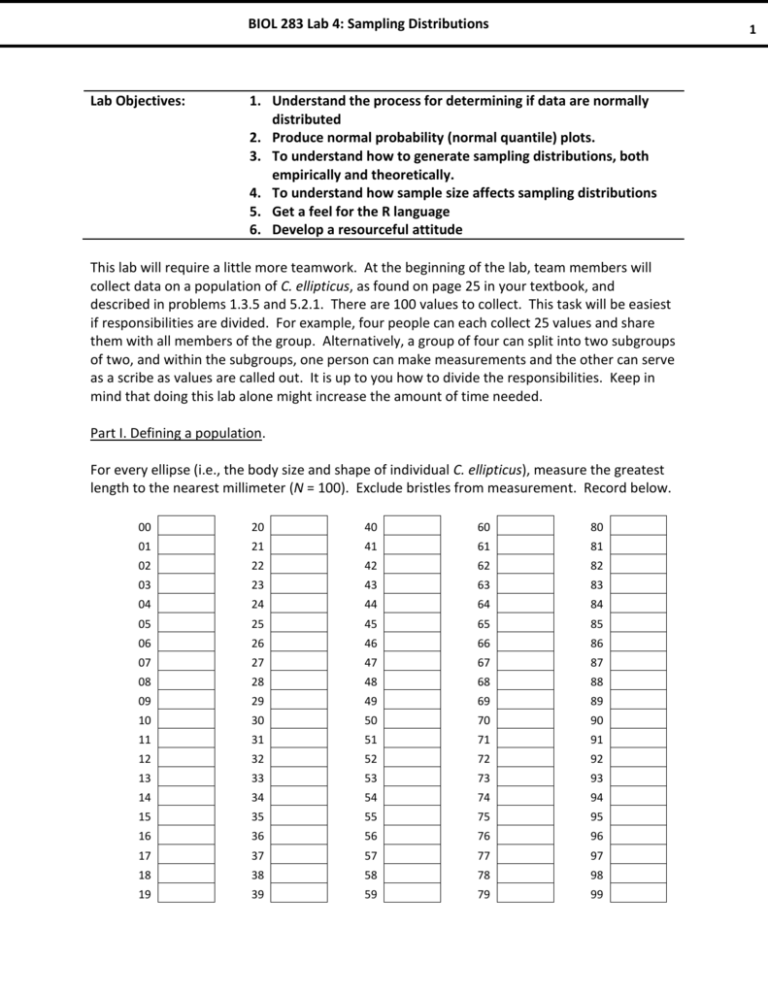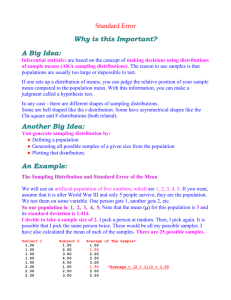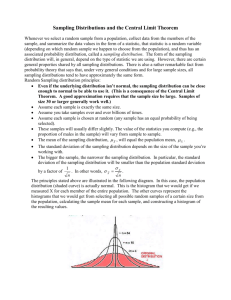biol.283.s2013.lab4.exercise
advertisement

BIOL 283 Lab 4: Sampling Distributions Lab Objectives: 1 1. Understand the process for determining if data are normally distributed 2. Produce normal probability (normal quantile) plots. 3. To understand how to generate sampling distributions, both empirically and theoretically. 4. To understand how sample size affects sampling distributions 5. Get a feel for the R language 6. Develop a resourceful attitude This lab will require a little more teamwork. At the beginning of the lab, team members will collect data on a population of C. ellipticus, as found on page 25 in your textbook, and described in problems 1.3.5 and 5.2.1. There are 100 values to collect. This task will be easiest if responsibilities are divided. For example, four people can each collect 25 values and share them with all members of the group. Alternatively, a group of four can split into two subgroups of two, and within the subgroups, one person can make measurements and the other can serve as a scribe as values are called out. It is up to you how to divide the responsibilities. Keep in mind that doing this lab alone might increase the amount of time needed. Part I. Defining a population. For every ellipse (i.e., the body size and shape of individual C. ellipticus), measure the greatest length to the nearest millimeter (N = 100). Exclude bristles from measurement. Record below. 00 20 40 60 80 01 21 41 61 81 02 22 42 62 82 03 23 43 63 83 04 24 44 64 84 05 25 45 65 85 06 26 46 66 86 07 27 47 67 87 08 28 48 68 88 09 29 49 69 89 10 30 50 70 90 11 31 51 71 91 12 32 52 72 92 13 33 53 73 93 14 34 54 74 94 15 35 55 75 95 16 36 56 76 96 17 37 57 77 97 18 38 58 78 98 19 39 59 79 99 BIOL 283 Lab 4: Sampling Distributions Now create a variable in R for the whole population. This can be done as, for example, Population = c(y1, y2, y3, …, yN) Where the values, yi, are data for the variable, Y, which is ellipse length in mm. Make sure you do this in the exact order of values presented in the table! Note that in R, one can use multiple lines for one command. This might make it easier to input data. For example, one can do the following (values are hypothetical): Population = c( 5, 6, 5, 12, 4, 3, 9, 10, 11, 8, 4, 9, 8, 6, 7, 12, 11, 4, 7, 9, …. …. ….) Thus, one can do 10 lines of 10 values, or 5 lines of 20 values, or any combination that makes it easier to know if you have input all 100 values. Part II. Collecting a sample from the population. To sample from the population in R, one can use the sample( ) function. Within the parentheses, add the variable name first, then a comma, then the sample size. For example, sample(Population, 20) draws a random sample of 20 subjects from the population (Note that Population means the name you gave the population). Note that failure to add sample size means that a random sample of N will be drawn, which effectively just mixes up the values of the population. It is wise to give the sample a name, so that you can refer to the data later. For example, s.20 = sample(Population, 20) s.15 = sample(Population, 15) 2 BIOL 283 Lab 4: Sampling Distributions Randomly sample 10 subjects from the population, and give it a name 3 What did R provide as output? Do you know which subjects were chosen? Do you know their lengths? Now write down the 10 values in increasing order i Value: 1 2 3 4 5 6 7 8 Now calculate the percentiles for each value (refer to text or notes) i 1 2 3 4 5 6 7 9 10 8 9 10 8 9 10 Percentile: Now calculate the adjusted percentiles (refer to text or notes) i 1 2 3 4 5 6 7 Adjusted Percentile: Now find the standard deviates for each score, assuming a standard normal distribution i z: 1 2 3 4 5 6 7 8 9 10 BIOL 283 Lab 4: Sampling Distributions Finally, make a normal quantile plot by plotting the observed values (y-axis) versus the quantiles, a. k. a. standard (normal) deviates (x-axis). You can do this by hand, or if you are savvy, you might try it in R. If you choose the latter, just delete the box below and add a graph that you made in R. (Make sure to label axes!) Do the data from the sample pass the “fat pencil” test? I.e., are they normally distributed? If not, what can you say about the distribution. (Feel free to use the hist( ) or boxplot( ) functions in R to attain a better understanding of distributional shape. This is why it was a good idea to give the sample a name) Provide a comment about your assessment of “normality” from the data. 4 BIOL 283 Lab 4: Sampling Distributions R has a short-cut for the analysis you just did. Simply use the function, qqnorm(sample), where sample means your sample name. Did you get the same result using the built in qqnorm( ) function? Explain. 5 BIOL 283 Lab 4: Sampling Distributions Part 2. Creating a sampling distribution. Before creating a sampling distribution, let’s take a look at the population. Using skills you have learned in this and prior labs, find the population mean and standard deviation, and comment on the shape of the distribution (using any plotting options you choose). Note: if you use the function sd( ), the standard deviation will be wrong, as sd( ) calculates the sample standard deviation. There are several ways to figure out the population standard deviation. Try to find your own and check with the instructor to make sure you did it right. Population parameters: μ: σ: Comment on distribution of lengths for the population. Use graphs if you like. Also comment on how you found the population parameters above. 6 BIOL 283 Lab 4: Sampling Distributions 7 Using the sample of 10 you found before, provide the sample mean and standard deviation in the table below. Also, repeat the sampling procedure you used to get your sample of 10 subjects, originally, 9 more times to produce a total of 10 sample means and standard deviations. Add those to the table below. In each iteration, calculate the mean and standard deviation of sample means for all iterations until that point. For example, in iteration 6 calculate the mean and standard deviation of 6 sample means from 6 iterations; in iteration 7, do the same for 7 values; etc. Iteration y s Cumulative mY (Calculate each time) Cumulative s Y (Calculate each time) 1 (original sample) 2 3 4 5 6 7 8 9 10 Now compare mY and s Y to m and s , respectively. What appears to be the relationship between the population and sampling distribution parameters? How might sample size contribute to your interpretation? BIOL 283 Lab 4: Sampling Distributions 8 Compare population and sampling distribution parameters. Are your results consistent with what you expect? Part 3. Determining the effect of sample size Instead of repeating the previous procedure many times with many sample sizes, download the companion R script and use it to determine how sample size affects the sampling distribution of Y . Use the script to fill in the table below, along with your own calculations. Then comment on how the “Law of Large” numbers and “The Central Limit Theorem” apply to this exercise, as well as what the resampling experiment demonstrates. 10 permutations n mY sY 50 permutations mY sY 100 permutations mY sY 500 permutations mY sY 1000 permutations mY sY 5 10 20 40 You can copy and paste plots at the end of this lab exercise, if it helps you remember the output for the future. s n BIOL 283 Lab 4: Sampling Distributions CHALLENGE: At which points in your simulation exercise did you find accurate results with respect to theory? What does this tell you about the “Law of Large Numbers” and the “Central Limit Theorem”? 9








